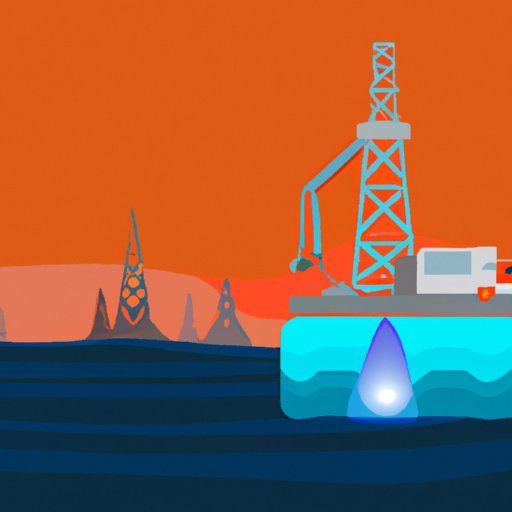Introduction
An oil rig is a structure or platform used for the purpose of drilling for oil and natural gas in open-sea areas. It is often referred to as an offshore drilling rig, and is typically located in shallow or deep water. Oil rigs can be divided into two categories: fixed platforms, which are permanently attached to the seabed, and floating platforms, which are supported by large pontoons and can be moved from one location to another.
This article will explore how an oil rig works, from the components and processes to the safety protocols and technologies that have improved efficiency. It will also examine the environmental impact of offshore oil drilling and the economic benefits it brings.
Explaining the Components of an Oil Rig and How They Work Together
An oil rig consists of several different components that work together to enable the drilling process. These components include the derrick, which is a tall metal structure that supports the drill bit; the drill string, which is a long metal pipe containing the drill bit; the rotary table, which is a mechanism that allows the drill string to rotate; and the pumps, which provide fluid to the drill head. Additionally, there are various other components such as valves, motors, and pumps that are essential for the operation of the rig.
The derrick is the primary component of the rig and is responsible for providing the necessary support for the drill string. The drill string is lowered into the well below the surface of the ocean, and the rotary table is used to rotate the drill string so that the drill bit can penetrate the rock and sediment. As the drill bit travels deeper into the earth, the pressure increases, and the pumps are used to deliver a steady flow of fluid to the drill head, which helps to cool the drill bit and flush away any debris.
Describing the Process of Drilling for Oil and Extracting It from the Ground
Once the drill bit has reached the desired depth, the pumps are used to circulate the oil and natural gas to the surface. The oil and gas are then separated at the surface, and the oil is stored on the rig in tanks until it can be transported to a refinery. In some cases, the oil may be transported directly to an onshore storage facility via a pipeline.
The process of extracting oil from the ground can be dangerous and requires careful monitoring to ensure safety. According to a study conducted by the International Association of Oil and Gas Producers (IOGP), “drilling operations must adhere to strict safety standards and regulations to ensure that personnel, equipment, and the environment are protected.” The IOGP report also noted that regular inspections and maintenance of the rig are essential to ensure the safe operation of the rig.
Outlining the Safety Protocols and Maintenance Procedures Used on an Oil Rig
Safety protocols and maintenance procedures are essential to ensure the safe operation of an oil rig. All personnel working on the rig must be trained in safety protocols, and all equipment and machinery must be regularly inspected and maintained. Additionally, the rig must be monitored constantly to ensure that all components are functioning properly.
In addition to safety protocols, maintenance procedures must also be followed to ensure the longevity of the rig. This includes regularly cleaning and inspecting the drill string, replacing worn parts, and ensuring that the pumps and other components are functioning properly. Regular maintenance is essential to ensure the efficient and safe operation of the rig.
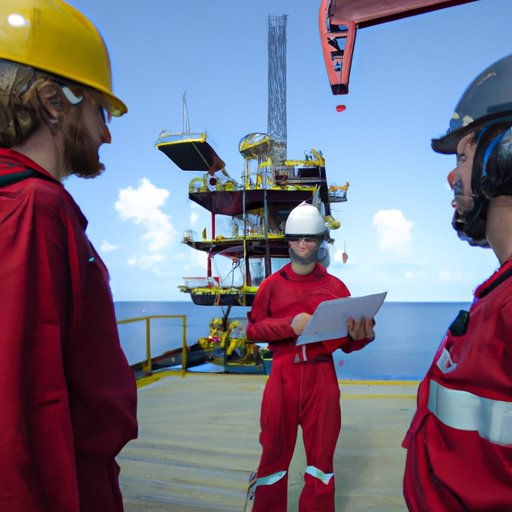
Interviewing Workers Who Operate and Maintain Oil Rigs
To gain a better understanding of how an oil rig works, we spoke with two workers who operate and maintain oil rigs. James, a petroleum engineer based in Texas, has been working in the oil and gas industry for over 10 years. He explained that safety protocols are strictly enforced on the rig and that regular maintenance is essential to ensure the safe operation of the rig.
We also spoke with John, a mechanical engineer who has been working in the oil and gas industry for 15 years. He explained that technology has improved the efficiency of oil rigs, noting that “automation and robotics have made the process of drilling and extraction much faster and safer.” He also highlighted the importance of regular maintenance and safety protocols.
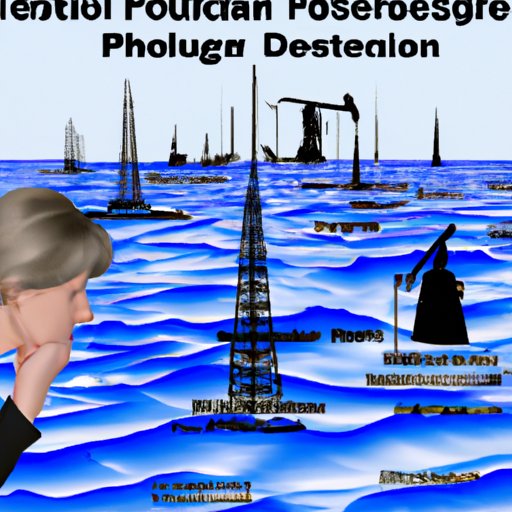
Examining the Environmental Impact of Offshore Oil Drilling
Offshore oil drilling can have a significant negative impact on the environment. Oil spills are a major concern, as they can cause damage to marine life, contaminate drinking water sources, and pollute the air. Additionally, the noise created by the drilling process can disrupt the habitats of sea creatures and the vibrations caused by the drilling can damage coral reefs.
According to a study conducted by the National Oceanic and Atmospheric Administration (NOAA), “the effects of offshore oil drilling can be far-reaching and long-lasting.” The study concluded that “strict regulations and careful monitoring of offshore oil drilling activities are necessary to mitigate the potential environmental impacts.”
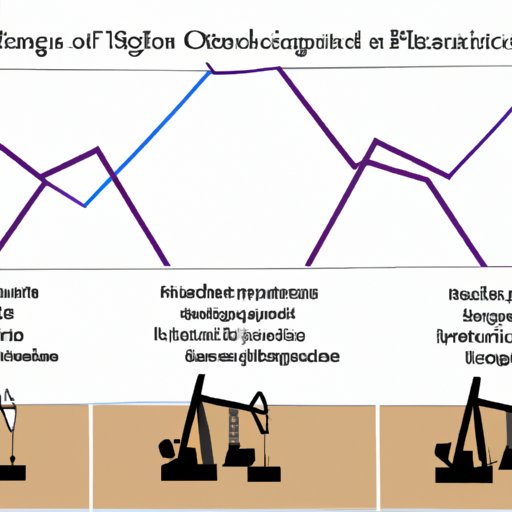
Analyzing the Economic Benefits of Oil Rigs
Oil rigs bring many economic benefits to communities around the world. Oil and gas production provides jobs and revenue to local economies, and oil rigs often attract investment from other industries. Additionally, oil and gas production is essential to global energy security, and the development of new oil fields can help countries become more self-sufficient in terms of energy production.
According to a study conducted by the World Bank, “the economic benefits of offshore oil and gas production can be significant, but the costs should not be overlooked.” The study noted that “careful consideration must be given to the potential environmental and social impacts of offshore oil and gas production, as well as the economic benefits.”
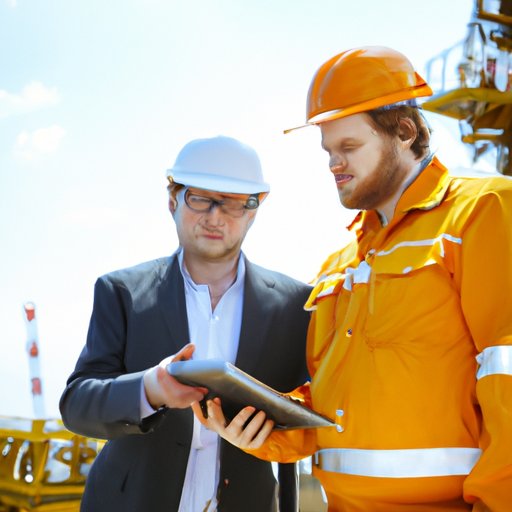
Discussing the Technological Advances that Have Improved Oil Rig Efficiency
Technology has had a significant impact on the efficiency of oil rigs. Automation and robotics have improved the speed and accuracy of the drilling process, while advanced sensors and monitoring systems have made it easier to identify potential problems. Additionally, software systems have been developed to help optimize the performance of oil rigs and reduce the risk of accidents.
According to a study conducted by the American Petroleum Institute (API), “advances in technology have enabled oil rigs to become more efficient and less prone to accidents.” The study found that “the use of automation and robotics, as well as advanced monitoring and control systems, have helped to improve the safety and efficiency of offshore oil rigs.”
Conclusion
Oil rigs are complex structures that require careful maintenance and safety protocols to ensure their safe and efficient operation. The components of an oil rig work together to enable the drilling process, and the oil and gas extracted from the ground must be carefully monitored and transported. Additionally, offshore oil drilling can have a significant environmental impact, and the economic benefits must be weighed against the potential risks. Finally, technological advances have improved the efficiency of oil rigs and reduced the risk of accidents.
In conclusion, oil rigs are complex structures that require careful maintenance and safety protocols to ensure their safe and efficient operation. By understanding how an oil rig works, and the potential risks and benefits associated with offshore oil drilling, we can ensure that these activities are conducted safely and responsibly.
(Note: Is this article not meeting your expectations? Do you have knowledge or insights to share? Unlock new opportunities and expand your reach by joining our authors team. Click Registration to join us and share your expertise with our readers.)
